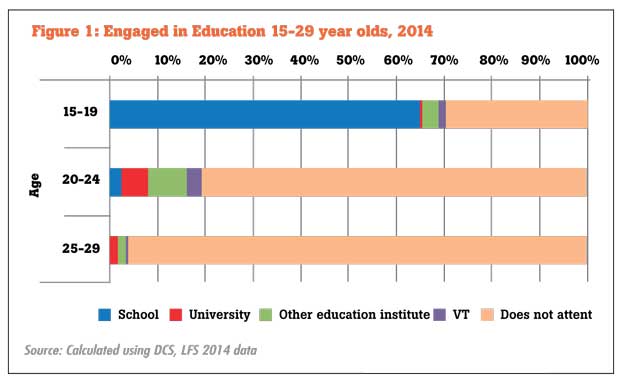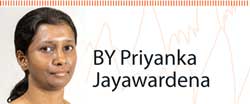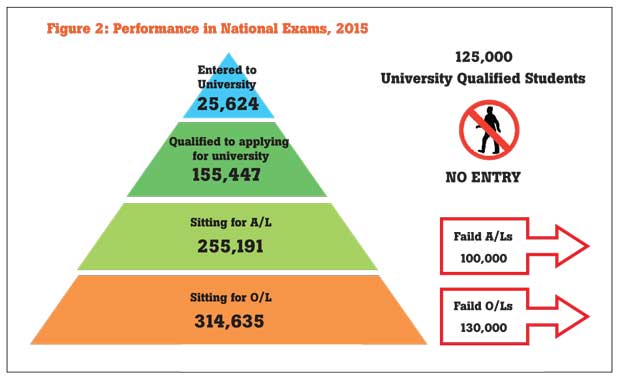22 Jun 2017 - {{hitsCtrl.values.hits}}

 According to the government’s economic policy statement issued in October 2016, Sri Lanka envisions achieving sustainable development by linking the country to global supply chains and increasing trade. The government hopes to create more exposure and opportunities for entrepreneurs and skilled professionals in various sectors, including the digital economy, tourism and commercial agriculture and to attain the status of a modern manufacturing economy. In this context, quality higher education and training are crucial if the Sri Lankan economy is to move up the value chain beyond the simple production processes and products.
According to the government’s economic policy statement issued in October 2016, Sri Lanka envisions achieving sustainable development by linking the country to global supply chains and increasing trade. The government hopes to create more exposure and opportunities for entrepreneurs and skilled professionals in various sectors, including the digital economy, tourism and commercial agriculture and to attain the status of a modern manufacturing economy. In this context, quality higher education and training are crucial if the Sri Lankan economy is to move up the value chain beyond the simple production processes and products.
Sri Lanka’s human capital is an essential resource in achieving the envisaged development goals and transforming the economy into a modern manufacturing one. Thus, it is increasingly important for the country to be equipped with new technological innovations and an educated workforce with market-oriented skills. High-quality human resources with expertise in science and technology and a skilled labour force are necessary, specially to compete globally.
Even lower-skilled jobs increasingly require talent and knowledge. As such, vocational training and secondary education need to prepare prospective employees for a complex, digital work environment. Today, Sri Lanka faces a major challenge in catering to these emerging skill requirements. In this backdrop, this article explores some policy options to bridge the skill gaps to achieve the government’s stated objectives.
A World Bank study on ‘Building the Skills for Economic Growth and Competitiveness in Sri Lanka’ based on a survey of employers’ perception of skill demand against the skills available in the workforce reveals 56 percent of employers consider that high-skilled workers should have passed A-Levels, while 70 percent of employers consider that low-skilled workers should have passed O-Levels.
But the real situation is, of the age 20 and above population, only 17 percent have passed A-Levels and another 17 percent have passed O-Levels (calculations based on LFS 2014 data). This means that there is a significant gap in meeting the skills demand of the country.

Also, today there is a rapidly growing demand for soft skills–especially English literacy and IT prowess. Individuals competent in English have access to better quality jobs with higher salaries and benefits in the domestic labour market, as well as internationally. The study mentioned above reveals that about 80 percent of employers expect higher-skilled workers to know English and 40 percent employers expect similar soft skills from less-skilled workers.
Similarly, 75 percent of employers expect higher-skilled workers to possess computer skills and 38 percent of employers expect similar soft skills from lower-skilled workers. However, calculations based on the Census of Population and Housing in 2012 show that, of the age 15 and above population, knowledge in English literacy (ability to speak, read and write) and computer literacy were around 22 percent and 23 percent, respectively, indicating a large skill gap.
Reasons for skill gaps
Sri Lanka’s tertiary enrolment rate is low. As of 2014, only 5 percent of 20-24-year-olds were enrolled in a university, while another 8 percent were enrolled in other educational institutions and only a 3 percent of the same age group were enrolled in technical education and vocational training (TEVT) courses (Figure 1). These figures indicate that the tertiary enrolment rates in Sri Lanka are quite low, compared to those of other countries in the region.
For instance, Sri Lanka’s gross tertiary enrolment rate (21 percent) is below the averages for lower-middle-income countries (22 percent) and upper-middle-income countries (44 percent), according to the World Bank’s World Development Indicators of 2014.
The main reasons behind Sri Lanka’s low tertiary enrolment rate are capacity constraints of the state university system, unavailability of a proper parallel higher education system with the private sector’s involvement and underdeveloped TVET. For example, the Central Bank of Sri Lanka (CBSL) annual report of 2016 shows that, of the 155,450 students who were eligible for university entrance from A-Level exams in 2015/2016, only 18.6 percent were admitted to state universities due to limited placements. Consequently, each year, about 125,000 students who qualify have to abandon their ambitions to enter a university (Figure 2).
On the other hand, with regards to vocational training, the transition from school to vocational training is not smooth. A majority of school leavers leave the education system after their O-Levels and A-Levels. Each year, about 300,000 students sit for O-Levels but only 50 percent- 60 percent of them passed O-Levels and qualify to sit for A-Levels.
Further, each year about 250,000 students sit for A-Levels but only 60 percent of them qualify to enter public universities. Thus, each year about 130,000 and 100,000 students leave the school system without succeeding at the O-Level and A-Level examinations, respectively.
Owing to this situation, most school leavers usually find unskilled work or engage in casual jobs. For example, calculations based on the Census of Population and Housing 2012 data show that only 4 percent (470,000) of the age 25 and above population have degree level education.
Further, only around 10 percent of age 20 and above population have formal professional or technical training relevant to their occupation. However, according to the World Bank study mentioned above, about 60 percent of employers expect workers in high-skilled occupations to have completed technical or vocational education and training and 24 percent think low-skilled workers should have received training. Thus, this limited number of workers with higher education acts as a constraint in meeting the labour market demand for skilled workers.
Limited opportunities in the state sector have resulted in the emergence of a parallel system of non-state sector higher education, with the establishment of private higher education institutes (HEIs) – many of which are affiliated to foreign universities. There are concerns among many stakeholders about the variability in quality among private HEIs. For example, the South Asian Institute of Technology and Medicine (SAITM) was recognized as a legitimate degree-awarding institute to award the degree of Bachelor of Medicine and Bachelor of Surgery (MBBS) in 2011, under the University Act, but it has garnered opposition from state university students and government doctors due to certain concerns on standards to be met and maintained, especially with regards to clinical training. This is mainly because there is no proper monitoring mechanism to ensure the quality of the programmes offered by such private HEIs.
Addressing critical concerns
School leavers are the prime target for specific training and skills development programmes aimed at meeting the skill demands of the country. Thus, a minimum of two years of training is recommended for students after sitting for O-Levels, to address the skill gaps of school leavers. Training programmes should be more work-oriented to suit different fields – such as hospitality, construction, textile and garment sectors, etc. Public-private partnerships and schemes of direct recruitment to the industry through vocational education and training institutes are essential.
The expansion of higher education opportunities in Sri Lanka have enabled many students, who would otherwise have studied abroad, to graduate locally at a considerably lower cost, saving foreign reserves and minimizing the outflow of knowledge (referred to as ‘brain drain’).
However, policymakers have to ensure that quality and standards are not compromised, through effective monitoring and control of private providers. The prevailing quality assurance mechanisms and regulatory systems have very narrow coverage, excluding the vast non-state HEIs functioning independently.
Thus, it is necessary to strengthen the regulatory mechanism of these institutes by incorporating new rules and regulations. It is crucial, therefore, to identify desired standards of these institutions with respect to their student recruitment criteria, fee structure, academic programmes, quality assurance and accreditation, etc. As in the case of SAITM and other institutes offering professional degrees, the first intake should be allowed only after the institute has obtained the compliance certification from the relevant professional body.
(Priyanka Jayawardena is a Research Economist at the Institute of Policy Studies of Sri Lanka (IPS). To view this article online and to share your comments, visit the IPS Blog ‘Talking Economics’ - http://www.ips.lk/talkingeconomics/)
08 Jan 2025 7 minute ago
07 Jan 2025 7 hours ago
07 Jan 2025 7 hours ago
07 Jan 2025 8 hours ago
07 Jan 2025 07 Jan 2025